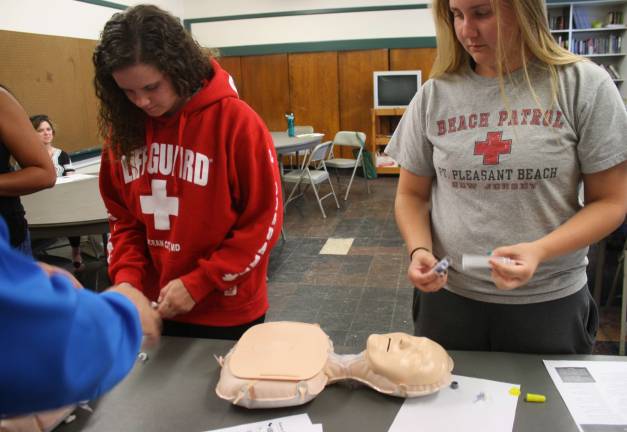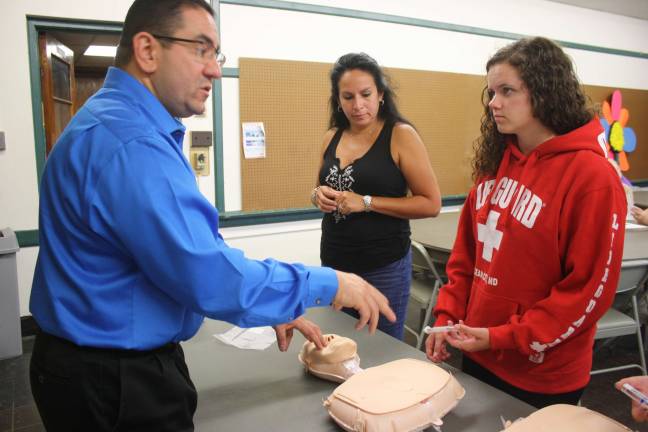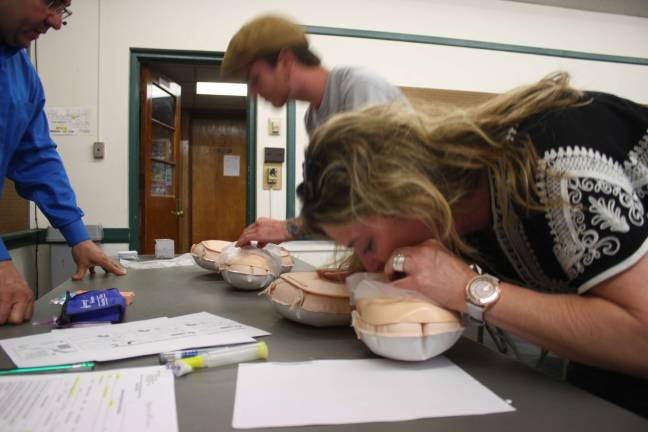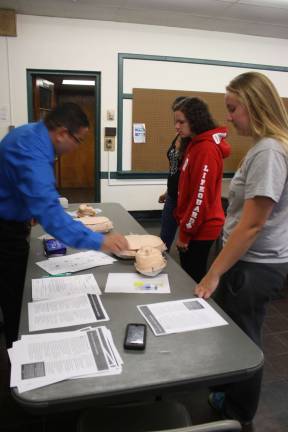Saving lives
| 21 Jul 2016 | 08:33

Melanie Dowling, left, and Peyton Porch, recent graduates of West Milford High School who both will be attending Misericordia University in Pennsylvania in the fal and majoring in health sciencesl, learn how to assemble a Narcan container before administering it.

Photos by Linda Smith Hancharick Victor Ferrer, an Emergency Department nurse at St. Joseph's Regional Medical Center in Paterson, instructs Evelyn Glueck, left, and Melanie Dowling on administering Narcan to an overdose victim.

The most important thing Ferrer stressed in the session was to breathe for the person in overdose. Participants practiced.

Victor Ferrer explains what to do before administering Narcan to someone suffering an overdose.
BY LINDA SMITH HANCHARICK
WEST MILFORD — Victor Ferrer has seen his share of emergencies. As an Emergency Department nurse at St. Joseph's Regional Medical Center in Paterson, he is on the front line of trauma.
Wednesday evening, Ferrer was on the front line again, this time in West Milford's Hillcrest Community Center, instructing residents on what to do in case someone they are with overdoses on opioids, including heroin.
Nine people got hands-on training in rescue breathing and administering Narcan, the overdose reversal medication. Each went home with a kit that included Narcan.
Recognizing an overdose
Ferrer instructed the group on recognizing the difference between an OD and someone who is high.If someone is high, he said, they will rouse when you shake them. Another test involves pain and pressure. Grind a knuckle into the person's chest really hard. If there is no response, grab their nipple and twist it. If there is no reaction, it is probably an overdose. Other signs of overdose are blue or purple lips and nails, gurgling sounds, vomiting and very shallow or no breathing.
What to do
First and foremost, Ferrer said call 911 and keep them on the phone with you until help arrives.Then begin rescue breathing. Ferrer explained the most important thing to do during an overdose is to keep oxygen circulating throughout the body. First give two breaths. The rule of thumb is to give one breath every five to eight seconds. But in a situation like this, you don't have to time it. Give a breath whenever you take one, he said. Don't give it forcefully; when the chest rises, stop the breath.
Administer Narcan. After the first two breaths are given, Ferrer instructed to put the Narcan syringe together. It's simple to assemble but he reminded that anyone doing this will be nervous.
"If you ever have to do this, you will be nervous," he told the group.
After assembling, push half of the dose in each nostril. It can take a few minutes to work, depending on the amount of opioid in the system. Continue breathing for them.
If there is no reaction to the Narcan in about two to four minutes, give another dose. And be prepared for what's next. Ferrer said Narcan puts the patient into withdrawal. They may become aggressive. Oftentimes, they will vomit, which is why he instructed to roll them on their side when they start to rouse.
When the person comes out of the overdose, Ferrer said it is important to stay with them, even following them in a car if needed. Narcan only works on opioids; there is always something mixed in with the opioids, he said, including blood pressure medication, cocaine and other drugs. The person can go back into an overdose state either from the other drugs or from the amount of opioid in their system.
How it works
The way heroin and other opioids work is that they bind to specific receptors in the brain; these receptors are also responsible for breathing. When they do that, they minimize the body's perception of pain and also limit breathing. Narcan knocks the opioid off the receptors, allowing the patient to breathe again. The Narcan won't stay on the receptors long though, depending on the amount of opioid in the system. Narcan only works on opioids, not other drugs. That is why the Narcan packages come with two doses to give in case the person reverts back to the overdose state.More training
St. Joseph’s Healthcare System is presenting another free training program on how to prevent a heroin/opioid overdose at the Hillcrest Community Center on Aug. 10, starting at 7 p.m. This program is sponsored by the West Milford Health Department, CASA and St. Joseph’s Overdose Prevention and Naloxone Distribution Program. Reserve a seat by calling 973-754-3000. For more information, call the West Milford Health Department at 973-728-2720.Hillcrest is located at 1810 Macopin Road.
For more photos from the training, go to westmilfordmessenger.com.